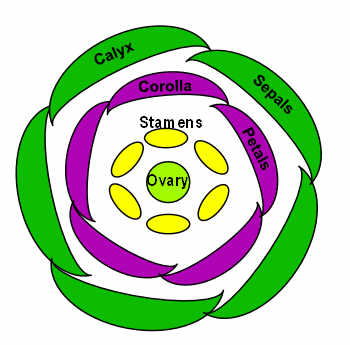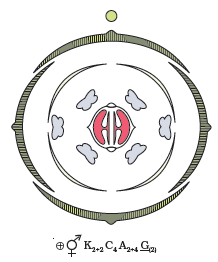- While describing an angiospermic plant, various morphological features are used.
- The description should be brief and scientific language or technical terms should be used.
- The description process begins first with the habitat, vegetative characters, floral characters, inflorescence and flower parts.
The floral characters are described using Floral Formula and Floral diagram.
Floral Formula
The different whorls of a flower, their number, adhesion and cohesion is represented as a formula known as floral formula. There are certain technical terms used in this formula.
| Br. | Bracteates |
| Brl. | Bracteolate |
 |
Actinomrphic |
| Zygomorphic | |
 |
Female |
 |
Male |
| Bisexual | |
| K | Calyx (sepals) |
| C | Corolla (petals) |
| P | Perianth |
| A | Androecium |
| G | Gynoecium |
- Fusion of any floral part is indicated by enclosing the figure in brackets.
- Adhesion is represented by drawing a line on the top of the two whorls connected
- The position of the ovary is shown by drawing a line above or below or middle position of G
E.g.: Br. Brl.  is a floral formula.
is a floral formula.
The formula tells that the flower is
- Bracteale
- Bracteolate
- Actinomorphic
- Bisexual
- Calyx consists of 4 sepals arranged in 2 bundles of 2 each.
- Corolla consists of 4 free petals (polysepalous)
- Androecium consists of 6 diadelphous stamens
- Gynoecium consists of 2 carpels with syncarpous and hypogynous condition.
Floral Diagram
The floral diagram represents the number of parts of a flower, its general structure, mode of arrangement, and their relations. It is the ground plan of a flower.

